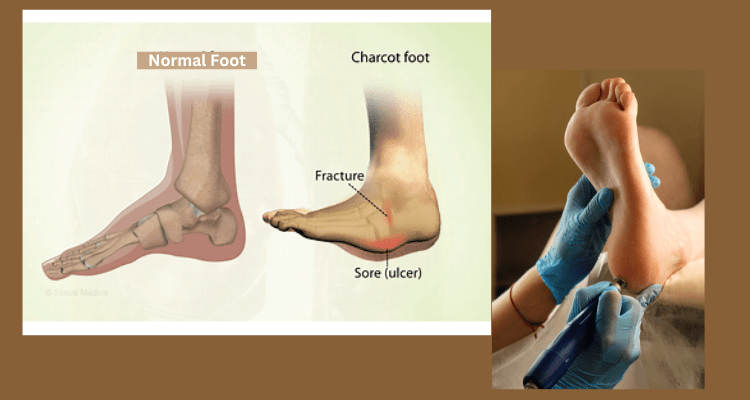Can Diabetic Foot Charcot Be Reversed? Exploring Hopeful Avenues Means Living with diabetes introduces a myriad of challenges, and among the lesser-known complications is Charcot foot. In this exploration, we venture into the realm of possibilities surrounding the reversal of diabetic foot Charcot, dissecting both conventional and burgeoning approaches to provide a beacon of hope and insights for those grappling with this condition.

Table of Contents
I. Introduction
A. Unraveling Charcot Foot’s Complexity : Charcot foot, also recognized as Charcot arthropathy, manifests as a condition characterized by the structural weakening of foot bones due to nerve damage. This intricacy often results in fractures and deformities, posing a substantial risk for individuals with diabetes.
B. The Crucial Battle Against Diabetic Foot Charcot : Addressing diabetic foot Charcot emerges as a critical imperative, capable of preventing severe complications such as foot ulcers and infections. Early intervention and adept management play pivotal roles in preserving mobility and averting disability.
C. Glimpses into Reversal Possibilities : The notion of reversing Charcot foot may seem audacious, yet recent strides in medical science and holistic methodologies cast a glimmer of hope for those impacted.
II. Understanding Diabetic Foot Charcot
A. Culprits and Risk Factors : Diabetic foot Charcot is often catalyzed by a confluence of factors, including neuropathy and compromised blood circulation. A profound comprehension of these root causes stands as a linchpin for effective management and potential reversal.
B. Manifestations and Diagnosis : Timely identification of Charcot foot symptoms is paramount. From swelling and redness to alterations in foot shape, prompt diagnosis facilitates timely intervention, enhancing the likelihood of successful reversal.
C. Beyond the Physical: Impact on Diabetics : The repercussions of Charcot foot transcend physical discomfort, influencing daily life, mobility, and mental well-being. Recognizing these challenges forms the foundation for a comprehensive management plan.
III. Traditional Approaches to Management
A. Orthopedic Anchors : Orthopedic interventions, encompassing braces and specialized footwear, aim not to reverse the condition but to provide stability and support, thwarting further damage.
B. Medications and Pain Alleviation : Managing pain and inflammation stands as a critical facet of This foot care. Medications and pain management strategies serve to enhance the quality of life for those grappling with this condition.
C. Lifestyle Nudges : Modest lifestyle adjustments, such as minimizing pressure on the affected foot, significantly contribute to Foot Charcot management. These modifications synergize with medical interventions, fostering a holistic approach.
IV. Emerging Trends in Reversing Diabetic Foot Charcot
A. Technological Leaps : Technological advancements, epitomized by wearable devices and smart insoles, herald innovative solutions in Charcot foot management. These technologies aspire to amplify mobility and real-time monitoring of foot health.
B. Pioneering Regenerative Medicine : The frontier of regenerative medicine unveils promises for Charcot foot reversal. From stem cell therapy to tissue engineering, researchers explore novel pathways to potentially restore damaged bones and tissues.
C. Rehabilitation Renaissance : Comprehensive rehabilitation strategies, integrating physical therapy and targeted exercises, gain prominence for their role in elevating mobility and functionality in those with Foot Charcot.

V. The Role of Diet and Nutrition
A. Balanced Diet Imperative : Maintaining a balanced diet emerges as pivotal for overall health, including bone health. Individuals with Charcot foot benefit from a nutrient-rich diet supporting bone strength and healing.
B. Essential Nutrients for Bone Health : Vitamin D, calcium, and other vital nutrients play pivotal roles in bone health. Ensuring an adequate intake of these nutrients contributes to the well-being of individuals with Charcot foot.
C. Tailored Dietary Recommendations : Personalized dietary plans, tailored to address the specific needs of those with Foot Charcot, become imperative. Consultations with healthcare professionals guide the formulation of these plans for optimal outcomes.
VI. Exercise and Physical Therapy
A. Tailored Exercise Alchemy : Customized exercise programs, focusing on strength and flexibility, prove instrumental in improving mobility for individuals with Charcot foot. These programs, under professional supervision, adapt to individual capabilities.
B. Physical Therapy’s Touch : Physical therapy assumes a pivotal role in the rehabilitation of individuals with Charcot foot. Targeted exercises, stretching routines, and gait training contribute to heightened mobility and functionality.
C. Embedding Movement into Everyday Life : Encouraging individuals to seamlessly integrate movement into their daily routines becomes paramount in averting further complications. Simple activities like walking and gentle exercises contribute to overall well-being.
VII. Patient Success Stories
A. Chronicles of Charcot Reversal : Real-life accounts of individuals triumphing over Charcot foot provide inspiration and hope. These narratives underscore the efficacy of a multifaceted approach to management.
B. Narratives of Resilience : Inspirational stories from those who have surmounted Charcot foot challenges offer valuable insights into the indomitable human spirit. These narratives extend encouragement to others facing similar struggles.
C. Lessons from Triumphs : Analyzing commonalities in successful outcomes unveils invaluable lessons. From prompt intervention to sustained follow-ups, these lessons guide individuals and healthcare professionals in the pursuit of Foot Charcot reversal.

VIII. Challenges and Limitations
A. Obstacles in the Reversal Odyssey : Despite strides, impediments impede the absolute reversal of Foot Charcot. Variables such as the severity of nerve damage, individual treatment responses, and underlying health conditions pose challenges.
B. Tailoring Solutions to Individual Challenges : Individualized challenges in the journey toward Charcot foot reversal demand understanding and tailored solutions. Acknowledging and addressing these patient-specific challenges are pivotal for effective care.
C. Navigating Risks and Complications : Awareness of potential risks and complications associated with treatment modalities is crucial. Transparent communication between healthcare providers and individuals with Charcot foot ensures informed decision-making.
IX. Future Prospects and Research
A. Evolving Studies and Clinical Prowess : Ongoing studies and clinical trials in the realm of Charcot foot reversal offer a glimpse into forthcoming treatment options. Staying abreast of research developments becomes vital for individuals and healthcare professionals alike.
B. Innovations Shaping Treatment Horizons : Continuous innovations in treatment approaches instill hope for enhanced outcomes. Staying informed about novel techniques and therapies empowers individuals with Charcot foot to explore the most efficacious options available.
C. Hope on the Horizon : Collective efforts from researchers, healthcare professionals, and individuals with Charcot foot foster hope for advancements in the near future. Collaborative initiatives strive to augment treatment options and overall quality of life.
X. Conclusion
A. Summing Up the Odyssey : In conclusion, the journey toward reversing diabetic foot Charcot necessitates a comprehensive approach. From traditional interventions to emerging trends, a fusion of strategies unveils hope and possibilities for those navigating this condition.
B. Empowering Those in the Charcot Struggle : To individuals traversing the labyrinth of Charcot foot challenges, maintaining hope and proactivity is pivotal. Seeking professional guidance, embracing lifestyle changes, and staying informed stand as transformative pillars in the journey toward reversal.
C. Advocating for Holistic Management : A holistic approach, amalgamating medical interventions, lifestyle modifications, and cutting-edge trends, proves paramount for effective Charcot foot management. Addressing the condition from multiple dimensions maximizes the prospects of successful reversal.
Also Must Read : What’s the Main Cause of Diabetes? must need
FAQs
1.Is Charcot foot reversible for everyone?
Reversal outcomes fluctuate based on individual factors. Early intervention and a comprehensive approach augment the likelihood of success.
2. Are there side effects with emerging treatments?
Potential risks and complications exist; individuals should engage in discussions with healthcare providers before opting for emerging treatments.
3. Can exercise exacerbate Charcot foot symptoms?
Customized exercise programs, under professional supervision, generally prove beneficial. However, individual capabilities should be considered.
4. Where can I find more information about ongoing research on Charcot foot reversal?
Keeping abreast of reputable medical journals and clinical trial databases, and consulting with healthcare professionals can furnish updated information.
5. How pivotal is diet in Charcot foot reversal?
A balanced diet, teeming with bone-supporting nutrients, contributes to overall well-being and aids in the reversal process.
